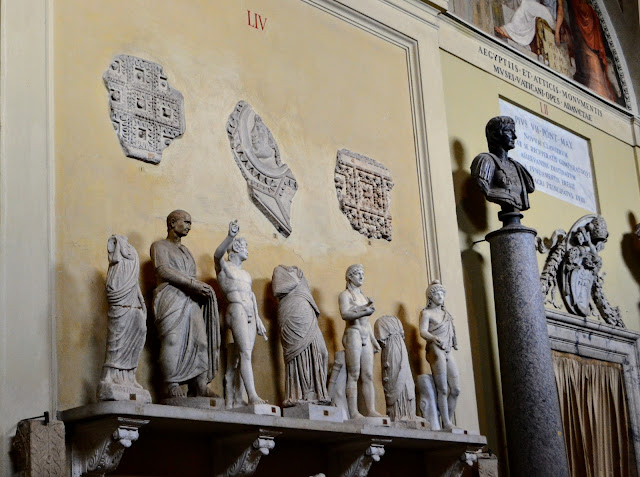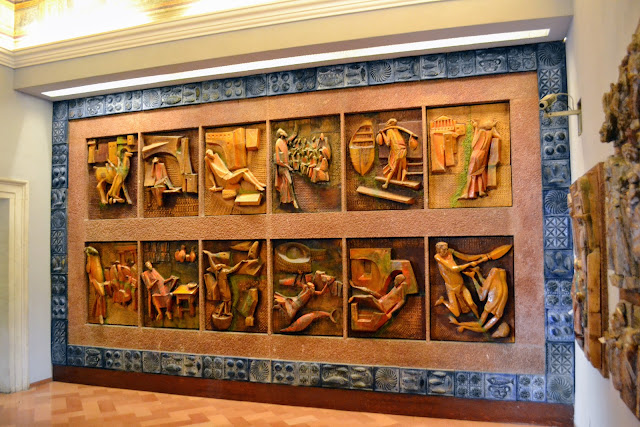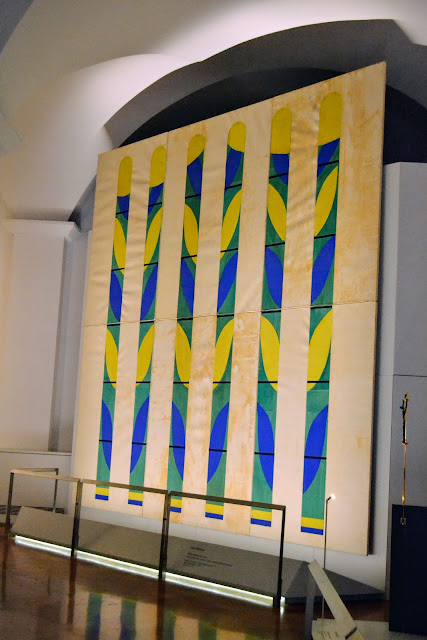Today we left the ship for the last time.
Our cruise is officially over, but we've opted to stay an extra day to visit the Vatican and other points of interest. It was a very wet day, and I was surprised to see a long going into the Vatican that went down the street, turned the corner and went around the block, and stretched nearly as far as the eye could see.
We sensibly bought "Skip the Line" tickets, which nearly every place offers for a price. Our guide told us it's not unusual for people to stand in line all day and not make it in before closing time.
I took a picture of this statue before we got through customs and was immediately swarmed by guards demanding I erase the picture. Oops. My bad. I took THIS picture after I got through security under the watchful eyes of the cranky guards who made sure I wasn't filming their procedure for security.
The Vatican is a city-state within the city of Rome. It occupies 110 acres and has numerous buildings.
Our first stop was the Vatican Museums. There are 54 galleries, and we wondered for a few hours through some of them.
The museums contain an enormous collection of 70,000 pieces, with about 20,000 on display.
The museums were founded in the early 16th century.
The collection was built over the centuries by the Popes and includes some of the best and most well-known works from ancient Rome and the Renaissance.
The museums include a number of sculpture museums
as well as a collection of modern religious art, and most famous of all, the Sistine Chapel.
The collection began will this marble sculpture, purchased 500 years ago. Called Laocoon and His Sons, it was discovered in 1506 in a vineyard and purchased by Pope Julius II. The pope soon put it on display, beginning the practice of exhibiting religious art at the Vatican.
Laocoon and His Sons shows the Trojan priest Laocoon and his sons being attack by sea serpents. It is believed to have been created between 27 BC and 68 AD and is in remarkable condition, although it is missing a few parts.
Our guide led us into Museo Chiaramonti. This museum is filled with Greek and Roman art.
We learned later in the day from a different tour guide that Rome has an agreement with the Vatican: whenever the city finds a statue or other work of art, they turn it over to the Vatican. This causes huge problems. Rome has been working on a much-needed new subway line for years. Every time workers find something, work comes to a halt, archaeologists are brought in, and the find is carefully dug up. Since, according to our guide, there is a find every few feet work on the subway line is very, very slow.
I learned, to my surprise, that most of these ancient statues and busts were painted. I've become accustom to the classic white marble look. You can see remnants of paint on some of the sculptures.
There were thousands of pieces in this museum. I've posted just a few of my favorites.
A child's sarcophagus from the mid 3rd century with figures of children playing, fighting, and socializing.
A variety of hairdos and head wear from "common people".
Sculptures were usually commissioned by the rich and famous. Most of the sculptures are unknown.
This is funerary
This poor fella has a stick growing out of his head.
An elegant armless woman
Every year my kids had toga day at the high school. They wore a sheet. Looks like that's toga material of yesteryear too. This is Tiberius as Jupiter, found in 1795.

How long do you suppose it takes to create this hairdo? This is known as a Flavian style, worn by aristocratic women from 69 AD to 96 AD
Considering the age of this sculptures, it's amazing many of them are in really good condition. Romans invaded Spain in 206 BC and were there as either communities or trade partners for hundreds of years.
This is a sculpture of a Dacian prisoner. He is wearing typical prisoner clothing and headgear, as well as a sad expression on his face.
I like the way the artist used this veined, purple-y marble for his clothing.
Roman sculpture borrowed heavily from the Greek creations, and many sculptures are copies or modeled after Greek works
Another example of using the natural colors of marble to enhance the sculpture.
Not all of the sculptures and statues have information.
Some of these statues and busts have been identified, others have not. Much can be known by clothing, hairstyles, and head wear.
A relief with theater masks. Actors wore masks to identify their characters.
One of a few children.
This is the funerary altar of Tullia Fortunata,who lived around the middle of the 1st century AD. It was reused in 389 AD to hold the portrait statue of Ragonius Vincentius Celsus. Recycling at its finest.
Personification of Autumn, found in 1804. It has been dated to the mid 2nd century.
Sculpture in Rome was considered to be the highest form of art, although painters disagreed. There was a lot of hostility between painters and sculptors, each claiming superiority over the other.
Statues were made in pieces, joined together with metal rods, which explains why ancient statues are so often missing an arm or hand. You can see the hole for the connecting rod at the end of this arm.
This museum is so large, we are only capable of seeing a small part of it.
Looks like a Hitchcock movie prop.
Sarcophagus with Bacchic (a Roman festival) procession and lion heads.
The Octagon courtyard.
Perseus Triumphant by Antonio Canova in 1804-1806.
Mosaic with tiny tiles.
The Vatican is so crowded with tourists. It's incredibly difficult to take pictures without including a random tourist. This warrior appears to have lost her spear.
I'm guessing this is the container they threw their sandals into when they came in the house.
This statue of River god (Arno) dates back to 117-138 AD. It has been restored and repaired extensively, including replacement of the head by Renaissance artists.
Unknown woman.
According to legend, Cleopatra bathed in this tub when she visited Rome.
I could not find information on this frieze, but I like the timeless center depiction of a child pulling on his mom's skirt.
Most sources do not believe this sleeping woman with a snake goes with the sarcophagus box beneath her.
This is the Jennings Dog, named after its first modern owner. It is a 2nd AD century copy of a 2nd century BC bronze. A man named Henry Jennings found it in the rubble pile of an antiques dealer sometime around the 1750's and purchased it.
This Laughing Mask was likely used on the walls of a theater as decoration. It is too heavy to be worn.
The Belvedere Torso, a fragment signed by Appollonios, son of Nestor, Athenian. He is completely unmentioned in any known record. Discovered in early 15th century, by the mid 16th century it was in the Vatican; how it got there is unknown. The torso dates back to the 1st century BC. The torso was crucial in Michelangelo's inspiration for the Sistine Chapel. It is considered to be one of the most remarkable masterpieces of the world, created by an unknown genius.
This is known as "Black and white mosaic with a hawk devouring a hare". There's a great pattern for our next entryway remodel.
These are some of the most beautiful mosaic floors I've seen.
This is the round room. It houses Nero's bathtub, which is made of stone quarried in Egypt. It is the only stone of its type ever found in the world. It's unique, not granite or quartz, but a igneous rock called "porphyry". Imagine the work involved to carry the stone from Egypt to Rome. 
Nero's tub was brought to the Vatican in the late 18th century. The room itself was built in the late 18th century and has mosaic floors from the Otricoli Baths of the second or third century.
Each sections depicts a battle between Greeks and a mythological creature.
Each tile was individually lifted from its original place in the Otricoli Baths and placed in the room.
The room is patterned after the Pantheon.
Around the room are niches with ancient statues.
The statues include Nerva, Roman Emperor from 96-98 AD
and Juno Sospita, ancient Roman goddess.
We left the Round Room and
headed to the Greek-cross Room
Sacrificing Gaius Caesar, Roman Emperor from 37-41 AD
One of two Roman telmones, or portal support. The come from the villa of an ancient Emperor of Rome, and though are Egyptian in style, they are Roman-made.
This is the elaborate sarcophagus of Constantia, daughter of Emperor Constantine the Great.
She died in 354 AD at the age of 37 of a sudden high fever.
Room of the Greek Cross with Sacrificing Gaius in the niche.
This area was built in 1786 through 1795.
In ancient Roman times, griffins were thought to be the king of all creatures. It was a sign of divine power and a guardian of treasure and priceless possessions.
Coat of Arms Pope Leo XIII, Pope from 1878-1903.
The standing boy is a copy of a 3rd century BC statue of a boy playing with a walnut. Playing with walnuts were favorite pastime of ancient children. This statue was found in 1784.
The sarcophagus shows the child on the box teaching children with attributes of Muses. The same child on top is busy studying, portraying a child who was intellectually inclined. It dates to the 3rd century AD,
The Sistine Chapel has the most famous ceilings in Rome, but there are a great number of other beautiful ceilings in the museums.
The amazing thing about these ceilings is that the are all completely flat. They have been painted using a technique called "Trompe l'oile" or fool the eye.
All. Completely. Flat.
Statue of Artemis, the fertility goddess, covered with...well, around here we call them Rocky Mountain Oysters.
I don't know what to call this. A plant stand? A large urn? A tall basin?
Basin on Three Sileni shows three forest spirits carrying a basin. Two of the Sileni were found in 1789. Ferdinando Lisandroni created the third Sileni, the basin, and the base in 1790.
An interesting pot.
Someone is missing his foot.
Lapis Lazuli floor
Looks like an Italian Wedding Cake.
The stuff of nightmares. Statue of an actor, 1st-2nd century AD.
We moved on to the Gallery of Tapestries.
These tapestries were created by Peter van Aelst's School. Pupils used the drawings from students of Rachael. Tapestries were used in these time periods as decoration, but also as a way of retaining heat and cold and sound reduction.
They date back to 1523-1534. It took 9 years to finish one tapestry. They are made of wool, silk, and gold and silver thread.
The bust of Janis, god of beginnings, gates, transitions, times, doorways, passages, and endings,
led us to the Raphael Rooms.
Originally, these were apartments for Pope Julius II (pope form 1503-1513).
Pope Julius II commissioned a young Raphael to redecorate the already existing rooms.
Raphael and his school began work in 1509.
After the death of Julius in 1513, Pope Leo X kept Raphael and his school on to finish the work.
Most of the works in these rooms are frescoes, painting done on wet plaster.
Raphael was only 25 when he began work on the rooms and much of his life was spent working here. He died in 1520 at the age of 37 after a 15 day fever. Lots of people of this time seemed to die of fever.
The ceilings are as grand as the walls.
Much of the ceiling work was done by Raphael's own teacher, Perugino.
An illustration of the power of Christ, who destroys the pagan statue.
Even the windows are incredible.
The Liberation of St Peter, one of the last works Raphael had a hand in, although it was mostly painted by students.
More trompe l'oeil. These frescoes are part and style of the Renaissance movement.
Disputation of the Holy Sacrament, the first work completed by Raphael in the Vatican.
The School of Athens. In this fresco, Plato and Aristotle are discussing philosophy to their eager students. In it Plato and Aristotle are discussing philosophy surrounded by eager students. Raphael has painted Leonardo da Vinci as Plato (the left figure in purple and pink robes). Raphael painted himself on the bottom left, the standing figure in flowing white robes, looking directly at the audience
The figure in blue lounging on the steps is architect Bramante, a contemporary of Raphael's, as philosopher Diogenes..
Heraclitus, an ancient Greek philosopher. Look at those knobby knees.
The Coronation of Charlemagne,
There are so many things to look at (and take pictures of) in this area.
The three Marys with Christ.
Blue ceilings...
....blue floors...
.....blue walls.
The window...
...and the view from the window.
Our final museum stop was the the Collection of Modern Religious Art, added in 1973.
Stained Glass Window of the Nave by Matisse, 1949.
Madonna by Lucio Fontana, 1956
Christ at the Scourging by Peter Hecker, 1973
Christ and the Painter, Chagall, 1951.
Madonna with Child, by Tsougoutharou Foujita,1920.
Portrait of Vrania G., by Lucio Fontana, 1949.
The Embrance, by Pedro Cano, 1944
Angelic Landscape, by Salvador Dali, 1977
Study for Pope II, by Francis Bacon, 1961
Our next stop is the Sistine Chapel.
No pictures are allowed in the Chapel.
The Sistine Chapel did not disappoint.
We were packed like clowns into a circus car in this space. I could hardly move.
We spent a long time gazing at the ceiling and walls.
Pinch me! I was really here!







































































































































I love Rome, the Vatican and the Sistine Chapel. The Laocoon may be my very favorite statue. The Sistine Chapel ceiling is eye candy. Very fun to read and enjoy.
ReplyDeleteAs soon as I saw your picture of the Laocoon, I knew Bob would comment on it. I remember him loving it. Good move on paying to skip the line. You need as much time as possible for something so magnificent!
ReplyDelete